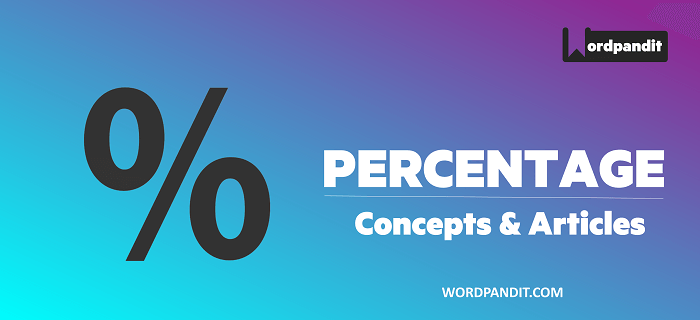In this article, we simply deal with the different types of problem based on Percentages. This lesson does not have any problems of its own but simply is based on the concepts we have studied so far.
Problem Type-1:
If a reduction of p % in the price of an article enables a person to buy y kg more for Rs R,then we can arrive at the following results:
Reduced price=> Rp/100y per kg
Original prices per kg= Rp/(100-p)y per kg
Example: A reduction of 21% in the price of an item enables a person to buy 3 kg more for 100. Thereduced price of item per kg is:
(a) Rs. 5.50
(b) Rs. 7.50
(c) Rs. 10.50
(d) Rs. 7.00
Solution:(d)
Reduced price will be:
Rp/100y per kg
In our case R= Rs. 100 , x=21% , y=3kg
{(100 x 21)/(100 x 3)} = Rs. 7
Alternate method:
Expenditure = price per quantity × consumption
E = P × Q =100……. (1)
Now, as per the question,

Problem Type-2: Problems based on mixtures
Example: A vessel has 60 L of solution of acid and water having 80% acid. How much water is to be added to make it solution in which acid forms 60%?
(a) 48 L
(b) 20 L
(c) 36 L
(d) None of these
Solution: (b)
Given, percentage of acid = 80%
Then, percentage of water = 20%
In 60L of solution, water = (60 x 20)/ 100 = 12L
Let p liter of water is to be added.
According to the question,
=>{(12 + p)/(60 + p)} x 100 = 40 (∵ 100 – 60 = 40% water)
=>1200 + 100p = 2400 + 40p
⇒ 60p = 1200
p= 20L
Problem Type-3: Problems based on Ratios and Fractions
Example: If the numerator of a fraction is increased by 20% and the denominator is decreased by 5%, the value of the new fraction become 5/2. The original fraction is:
(a) 24/19
(b) 3/18
(c) 95/48
(d) 48/95
Solution: (c)
Let original fraction be p/y
According to the question,
{(120/100)p/(95/100)y} = 5/2
120p/95y = 5/2
=> p/y = (5/2)x (95/120) = 95/48.
Problem Type-4: Problems based on Income, salary, expenditure
Example:The monthly income of a person was Rs 13500 and his monthly expenditure was Rs 9000. Nextyear his income increased by 14% and his expenditure increased by 7%. The per cent increase inhis savings was:
(a) 7%
(b) 21%
(c) 28%
(d) 35%
Solution: (c)
Given, monthly income = 13500 and expenditure = 9000
Then, original savings= Rs. (13500-9000) = Rs 4500
New income = 114% of Rs. 13500 = Rs 15390
New expenditure= 107% of Rs 9000 = Rs 9630
New saving = Rs. (15390 – 9630) = Rs 5760
NS = new savings
OS = Original savings
Percentage increase in savings = {(NS – OS)/OS} X 100
{(5760 – 4500)/4500} X 100 = (1260/4500)X 100 = 28%
Percentages: The Complete Lesson
Table of Contents
Tests









Thank you, explained very clearly.
Thanks
I liked the type of questions explained very clearly